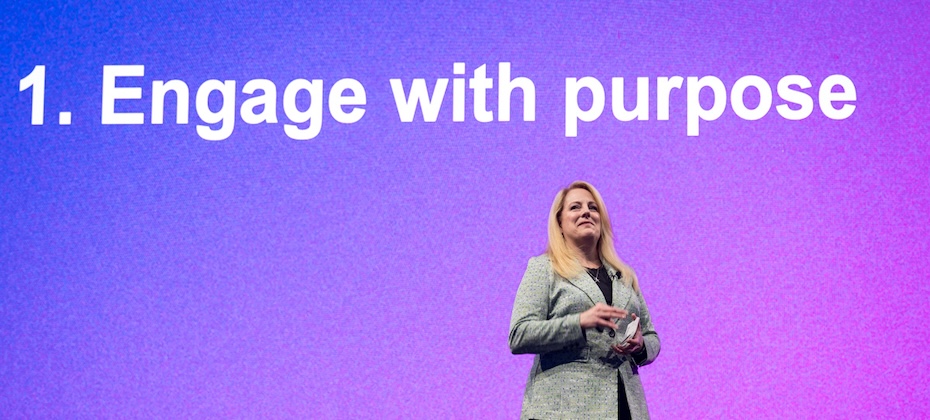NA – North America
News about Experian North America:

The challenge for financial institutions today is to understand the individuals who are applying for credit and to provide everyone with equitable opportunity to gain access to credit, provided they are an acceptable risk. In my current role as CEO of Experian Software Solutions, I am often reminded of my own journey as an immigrant to America who had to navigate the tests and complexities of establishing my financial identity and eligibility. I understand firsthand how inefficiencies caused in part by fragmented software systems have led to inflated costs, extended timelines, and elevated risks for financial institutions around the globe. Not to mention the profound impact this approach can have on consumers. At Experian, we recognize the need for change, which is why we developed Experian Ascend Platform™— an innovative solution designed to integrate critical functionalities seamlessly. Already, more than 1,500 clients globally are leveraging the platform, processing millions of transactions daily. Today, we’re unveiling new enhancements to the platform that bring together software tools for analytics, credit decisioning and fraud into a single interface — simplifying the deployment of analytical models and enabling businesses to optimize their practices more frequently, achieving greater efficacy with lower investment of time and money. Why does this matter? Well, consider the challenges faced by businesses, especially in the financial sector, when it comes to integrating various software solutions. “Complicated spaghetti” is what executives from some of the largest global banks have called it in conversations with me. Historically, achieving a synchronized experience across different tools and applications has been elusive to the industry. This fragmented approach not only stretches timelines unnecessarily but also raises security concerns and increases operational challenges and costs. Our enhanced platform addresses these pain points head-on. It dramatically reduces time to value while eliminating compliance risks and offers streamlined access to Experian's suite of integrated solutions and tools through a single sign-on and user-friendly, harmonized user interface. Moreover, it leverages generative AI to facilitate seamless automation, modernization, and efficiency across organizations of all sizes and experience levels without compromising human checks and controls. Our platform brings together worldclass Experian data, partner data and our clients' data with the software in one environment. There is no other platform on the market that offers the level of sophisticated integrations we do or that can "turn on" new solutions as quickly. To put it simply, it's a revolution for this industry. By combining analytics, decision-making, and fraud detection into a single platform, we're simplifying operations, enhancing security, and accelerating time to value for financial institutions worldwide. Let me give you an example. Lendr, a specialized fintech offering financing solutions for small businesses, has experienced firsthand the platform's transformative impact on agility, competitiveness, and informed decision-making. In fact, over the last year, the platform has already helped Lendr double their business. Our journey to developing the platform wasn't easy. It has required years of strategic collaboration with many of our most sophisticated clients, significant investments in technology, and a relentless pursuit of innovation. But the result is a platform that is revolutionizing the financial services industry and paving the way for a more inclusive, secure, and seamless financial future for all. As we continue this journey of transformation, I'm excited about the possibilities that lie ahead. With our integrated platform, we’re not just transforming the industry—we're empowering individuals and institutions to thrive.

We’ve reached a meaningful milestone with the launch of Experian Cashflow Attributes™. Now, lenders can tap into over 900 income, cashflow and affordability attributes from Experian across the customer lifecycle – which can provide a more accurate view of consumers’ financial health.

Innovation isn't just about creating the next big thing. It can solve problems, improve lives, and help businesses stay ahead in a rapidly changing world. So, what drives innovation? It starts with a culture of collaboration and entrepreneurship that inspires creativity. Our North America headquarters are in the center of Orange County, a community that fosters an environment where ideas flourish and partnerships thrive. For years, we’ve worked with Octane, a local non-profit organization focused on driving innovation and growth by connecting people, resources and capital to build a better future. Experian is committed to disrupting the status quo and supporting an environment where creativity can be unleashed. Armed with the power of data and the latest technologies, such as generative AI, we believe we can help better financial outcomes for the consumers and businesses we serve. I recently gave a keynote at Octane’s annual Tech Innovation Forum during OC Innovation Week, exploring how businesses can unleash creativity through the use of generative AI and highlighting five tenets companies can consider for the responsible use of generative AI, including: Engage with purpose: It’s important that companies identify their purpose in using the technology and how it can positively impact their business, employees and customers. They should start with creating a plan, including deciding who will be using AI, what jobs need to be done, what guidelines need to be set and a review process. Elevate creativity and drive automation: Businesses should harness AI to automate processes that are mundane or labor-intensive to enable employees to focus more of their time and energy on creativity. Excite, educate, and train employees: To ensure all employees understand the potential of generative AI, businesses should prioritize education and training for all employees from the start. This includes finding evangelists of the new technology within the company to stay up-to-date on the latest news and get teams excited about the possibilities. Ensure ethical, compliant and responsible use: In addition to employee trainings, it’s important to set up a group of leaders, such as a risk council, that can handle ongoing opportunities and risks and codify guidelines on the ethical usage of AI. Embrace change and be agile: With any new technology, companies need to be agile and ready to adapt to whatever changes may come. It’s important to foster a culture of learning to constantly evolve the generative AI landscape for the company and its clients. Innovation can fuel economic growth, drive progress, and shape the future. We’re dedicated to fostering a culture of innovation and collaboration that creates opportunities for generations to come. Photo by © Octane/Michael Baker

In a panel discussion at a Bloomberg-hosted panel titled "AI and Data Analytics: The Path to Unleashing Hidden Insights," Diksha Gera, a Senior Analyst at Bloomberg Intelligence, moderated a session that included key insights from Shri Santhanam, Executive Vice President and General Manager of Software, Platforms, and AI at Experian. Santhanam shared his thoughts on the transformative influence of generative AI (GenAI) within the financial sector, underlining its potential to revolutionize traditional practices. Enhancing Core Processes Santhanam illustrated how GenAI is altering the landscape of financial institutions. By automating intricate tasks, improving customer interactions, and expediting product development, this technology is pivotal. It transforms time-intensive tasks into more efficient processes, significantly enhancing productivity. This shift allows employees to focus on more strategic, higher-value work, thereby boosting the overall efficiency of financial institutions. Managing Risks and Ensuring Compliance With the adoption of GenAI comes a host of inherent risks—privacy concerns, data integrity issues, and challenges in regulatory compliance. Santhanam underscored the critical need to balance these innovative strides with stringent security measures that protect customer data and comply with existing regulations. The commitment to aligning practices with regulatory standards and ethical guidelines is paramount as the financial sector continues to integrate AI into its core operations. Governance and Collaboration Effective governance is essential for the successful deployment of GenAI in finance. Santhanam advocated for a collaborative approach that includes risk management, legal, and technical teams. The development of robust governance frameworks supports ethical and compliant AI applications, which are crucial for fostering responsible innovation within the industry. The Future of GenAI Looking forward, Santhanam pointed to several trends that are shaping the future of GenAI in the financial sector. These include pressures to reduce costs, increased demand for personalization, and the necessity for user-friendly interfaces. GenAI is set to play a key role in delivering personalized, efficient, and accessible financial services that respond to the evolving needs of customers. These insightful discussions, spearheaded by industry leaders like Bloomberg and moderated by experts such as Diksha Gera, emphasize Experian's leading role in navigating the potential and challenges of AI in financial services. The journey towards a more innovative and inclusive financial ecosystem is well underway, driven by the transformative capabilities of GenAI.

Like many people, money and personal finance were not topics often talked about when I was growing up. The same was true when it came to credit. In fact, I was raised to believe credit was something to avoid. I didn’t learn credit can be a financial tool to unlock many of the things we want in life until I was much older. This meant I learned a lot about credit and personal finance by making mistakes. And new research reveals this is the case for many Americans. Understanding credit and personal finance is paramount for financial well-being, especially for younger generations navigating today's financial landscape. Yet, against the backdrop of Financial Literacy Month, our new research shows a lack of financial knowledge is leading to costly financial mistakes for many. In fact, our survey of 2,000 adults across the U.S. revealed three in five adults feel their limited understanding of credit and personal finance has led them to make financial mistakes, with 60% of this group stating these mistakes have cost them $1,000 or more. This trend is particularly apparent among younger groups with 71% of Gen Zers and 70% of Millennials claiming their inadequate knowledge of credit and personal finance has come at a price. Twenty-nine percent of Gen Zers and 38% of Millennials report these financial mistakes have cost $5,000 or more. ADDITIONAL KEY FINDINGS INCLUDE: STATEMENT TOTAL GEN Z MILLENNIALS GEN X BOOMERS SILENT I have poor or no understanding of credit and personal finance 12% 18% 14% 12% 7% 0% I want to know more about credit and personal finance 66% 80% 79% 63% 48% 47% My limited understanding of credit and personal finance has led me to make financial mistakes. 60% 71% 70% 61% 44% 24% Financial mistakes I’ve made due to my limited understanding of credit and personal finance have cost me: $5K or more 37% 29% 38% 43% 33% 38% $1K or more 60% 58% 63% 64% 52% 63% $10K or more 23% 12% 22% 31% 24% 38% I learned about credit and personal finance: Through online research 32% 25% 36% 35% 27% 32% In school, college or community classes 33% 35% 26% 35% 35% 38% From a parent of family member 36% 31% 30% 38% 42% 47% Social media in some form 30% 52% 47% 24% 7% 0% I believe personal finance should be a required course in high school. 78% 72% 72% 81% 85% 88% I believe access to credit plays a significant role in my overall financial health. 80% 77% 82% 81% 78% 88% Bridging the Knowledge Gap These statistics underscore the importance of ongoing financial education. It's evident there's a strong desire among individuals, especially younger generations, to enhance their understanding of credit and personal finance. However, without adequate knowledge, many are susceptible to making costly financial mistakes. Navigating the mainstream financial system has its complexities, and if consumers don’t have a baseline understanding, it can be overwhelming. At Experian, we're committed to bridging this knowledge gap and empowering individuals to take control of their financial futures. We offer a range of free tools and resources designed to educate and empower consumers, including: Free Credit Reports: Gain insight into your credit history and monitor your financial health with a free copy of your Experian credit report and FICO Score®[1]. You can access these through our free mobile app or our website. Credit Monitoring: Stay informed about changes to your credit report and receive alerts about potentially fraudulent activity as part of our free Experian membership. Educational Resources: Check out our official credit advice blog, Ask Experian, where you'll find answers to common questions and expert advice on credit-related topics. Experian Boost®: Take advantage of this innovative tool to potentially improve your credit scores by adding positive telecom, utility, and other payments to your credit file.[2] Experian Go™: If you're new to credit, our mobile app offers a free membership to help you establish and build credit responsibly. Join Us in Celebrating Financial Literacy Month I also encourage consumers to join Experian’s weekly #CreditChat hosted by @Experian on X with financial experts every Wednesday at 3 p.m. Eastern time. In recognition of Financial Literacy Month, consumers can learn personal finance basics from experts each week on topics, including budgeting, savings, credit and debt, and more. Survey Methodology Experian commissioned Atomik Research to conduct an online survey of 2,005 adults throughout the United States. The makeup of the sample is representative of the U.S. population based on national census data regarding demographic variables such as gender, age and geographical regions. The margin of error for the overall sample is +/- 2 percentage points with a confidence level of 95 percent. Fieldwork took place between March 17 and March 21, 2024. [1] Credit score is calculated based on FICO® Score 8 model, unless otherwise noted. In addition to the FICO® Score 8, we may offer and provide other base or industry-specific FICO® Scores (such as FICO® Auto Scores and FICO® Bankcard Scores). Your lender or insurer may use a different FICO® Score than FICO® Score 8 or such other base or industry-specific FICO® Score (if available), or another type of credit score altogether. Learn more. [2] Results will vary. Not all payments are boost-eligible. Some users may not receive an improved score or approval odds. Not all lenders use Experian credit files, and not all lenders use scores impacted by Experian Boost®. Learn more.

Experian’s purpose-driven culture is woven into our company’s DNA and informs everything we do. It empowers our people to thrive and excel in their roles. Additionally, it fosters a high-performance workplace centered on diversity, equity, inclusivity and making a positive impact on the communities where we and our families work, play and live. Our culture of innovation and “Together, We Win” workplace is a driving force behind Experian North America being named to Fortune’s 2024 100 Best Companies to Work For list for the fifth consecutive year. Great Place to Work® sponsors the prestigious Best Companies list, surveying more than 1.3 million employees and gathering data from companies representing more than 7.5 million employees. The survey enables employees to share confidential feedback about their organization’s culture by responding to 60 statements that – when put together – describe their experience, defined by levels of trust, respect, credibility and more. According to the Great Place To Work® 2024 Global Employee Engagement Study, 90% of employees at Experian say it is a great place to work compared to 57% of employees at a typical U.S.-based company. Ninety-three percent of respondents cited that they were “made to feel welcome” when they joined the company, and 91% indicated that they are “proud to tell others [they] work [at Experian].” This recognition continues Experian’s momentum with recent award wins, including winning the 2024 BIG Innovation Awards from the Business Intelligence Group; earning the top score on the Disability Equality Index® (DEI) for the second consecutive year; being named a 2023 “Best Place to Work for Disability Inclusion” by the American Association of People with Disabilities (AAPD) and Disability:IN; being recognized with the prestigious Fast Company 2023 World Changing Ideas Award for Experian Go™, a free program that empowers “credit invisibles” to establish their financial identity within minutes; and being named to Fortune’s America’s Most Innovative Companies list in 2023.

While cheering on your favorite tournament team during March Madness, basketball fans can become MVPs in financial literacy with Experian’s B.A.L.L. for Life™ (Be a Legacy Leader) gesture-controlled game. On the virtual court, the game can help students create their own shining moment in their financial health journey. The B.A.L.L. for Life program helps young adults and their families set up a game plan to building generational wealth; the gesture-controlled game tests players’ knowledge about credit. Credit and financial coaches teach the basics of budgeting, saving, credit, investing, homeownership and more. B.A.L.L. for Life debuted at the 2023 Iverson Roundball Classic, for which Experian has supported as the exclusive financial literacy partner since 2022. Back then, a younger Cason Wallace (now with the Oklahoma City Thunder) talked with our Chief Diversity and Talent Acquistion Officer Wil Lewis and Experian partner and recording artist Lecrae about the importance of understanding money matters. B.A.L.L. for Life serves as a catalyst for engaging with young adults and people who are credit invisible through live events and digital financial education. It powers in-person experiences such as the #IYKYK Pitch Competition (If You Know You Know) featuring HBCUs across the country, and The Legacy League Game Show which was part of the National Urban League’s 2024 Empowerment Summit. B.A.L.L for Life kicked off its college tour in November at the University of Texas San Antonio; Shaw University and Morgan State University will be its next stops in April. To learn more about B.A.L.L. for Life™, visit experian.com/legacy.

We often say creating a better tomorrow isn’t just a slogan, it’s our goal. From our talent recruiting to our products and services, we want to play a positive role in your financial future. That desired impact extends to the work we do in the communities in which we live work and serve. That’s why our recent honor from the 2024 Anthem Awards is so exciting. Created in 2021 by The Webby Awards, The Anthem Awards honors the purpose and mission-driven work of people, companies and organizations worldwide. We are thrilled that our modern and more relatable approach to financial health has been honored with a Bronze Anthem Award for the video series, “HeartBroke,” produced in partnership with The Singleton Foundation. As part of our United for Financial Health initiative, the show brings together couples for frank and honest conversations about their finances and how relationships are tested with financial issues. Financial expert Misty Lynch coaches them through those issues to help them determine if they can work through it or end up HeartBroke(n). It’s no surprise that money matters can put enormous strain on relationships and our daily lives. That’s why we’re also working with The Singleton Foundation to help young adults master money basics in the show “Your World on Money.” Now in its second season, “Your World on Money” explores topics like insurance, how to negotiate your salary, credit invisibility and stock market basics. It's exciting to be among the distinguished winners honored this year. But for Experian, helping you feel empowered when it comes to your credit and finances is the bigger reward.

Experian celebrates its fifth consecutive year of achieving the highest score in the Human Rights Campaign's Corporate Equality Index (CEI), solidifying our position as a leader in LGBTQ+ workplace inclusion. Our enduring commitment to LGBTQ+ equality and inclusion has not only earned us this prestigious recognition, but also underscores our dedication to fostering a diverse and inclusive workplace where everyone can thrive. Michele Bodda, Executive Sponsor of Experian’s PRIDE ERG said, “I am incredibly proud to see our company achieve this milestone recognition again. It's a testament to the dedication of our entire Experian family in fostering an inclusive and accepting workplace where everyone can be their authentic selves.” LGBTQ+ Workplace Inclusion in ActionOur score of 100 in the 2023 CEI is a testament to our continued efforts in promoting LGBTQ+ workplace inclusion. Here are some of the initiatives that exemplify our commitment: Progressive Benefit Programs: Experian offers comprehensive benefit programs that encompass transgender services and provide equal coverage to same and different-sex domestic partners and spouses. These benefits support the diverse needs of all our employees. Non-Discrimination and Equal Employment Policies: Our non-discrimination and equal employment policies are committed to fairness and respect for all employees, transcending federal requirements and embracing inclusivity without regard to gender identity or sexual orientation. Transgender and Nonbinary Identity Support: We've created a process for transgender and non-binary individuals to update their identity documentation without emotional and financial strain. We also suppress their former names (deadnames) from Experian credit reports. The Power of YOU Initiative: To foster an inclusive work culture, Experian actively supports LGBTQ+ employees through initiatives like the Power of YOU campaign and the PRIDE Employee Resource Group. Check out the 2023 Power of You DEI Report to learn more. Celebrating five consecutive years of earning the highest possible score on the CEI is a milestone that underscores our continued dedication to creating an inclusive work environment where every employee, feels supported, valued, and empowered. For more information on our HRC Award and the 2023 Corporate Equality Index, check out the full report here. You can also learn more about Experian’s awards for our work supporting consumers, businesses, and our employees here.